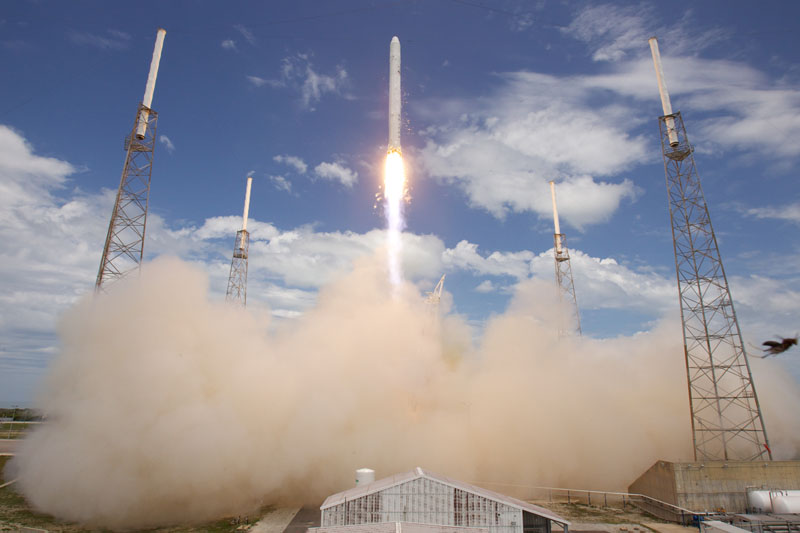Private Falcon 9 Rocket Meets Fiery End After 3 Weeks in Space

After riding a flame into Earth orbit morethan three weeks ago, the dormant upper stage of the first Falcon 9 rocketplunged back into the atmosphere Sunday, a fiery finale for the historicprivately-developed spacecraft.
The rocket and its dummy payload around 0050 GMT Sunday (8:50 p.m. EDT Saturday), according to U.S. militarytracking data, but the margin of error is roughly two hours in eitherdirection.
At 0050 GMT Sunday, the truck-sized vehiclewould have streaked back into the atmosphere and burned up over Iraq and Syria.But the uncertainty in the exact re-entry time means the rocket and Dragoncapsule could have come back to Earth anywhere along its ground track for morethan two orbits.
Most of the 12-foot-wide rocket stage likelyburned up during re-entry.
The Falcon second stage and cone-shapedDragon spacecraft remained bolted together after launching June 4 from Cape Canaveral,Fla. The attached duo entered an orbit approximately 155 miles high with aninclination of 34.5 degrees, reaching a trajectory very close to its launch targetwithin 10 minutes of liftoff. [Photos: Falcon 9Rocket's 1st Launch]
About one hour later, the Falcon 9 secondstage passed over Australia as it vented excess propellant from its fuel tanks.The rocket was spinning, displaying a corkscrewing cloud of vapor that touched off UFOreports.
As expected, the vehicle's batteries ran outof power shortly after launch, leaving the inert rocket and spacecraft flyingout of the control of engineers on the ground.
Get the Space.com Newsletter
Breaking space news, the latest updates on rocket launches, skywatching events and more!
With a mass of around 15,000 pounds, therocket stage and stripped-down Dragon capsule succumbed to small forces ofatmospheric drag in the weeks after launch. The drag naturally lowered thecraft's orbit until Earth's atmosphere eventually captured the empty rocket forre-entry.
During its 22 days in space, the rocketcompleted more than 300 orbits of Earth and traveled nearly 10 million miles.
As the first Falcon 9 rocket spent its dayscircling the planet, SpaceX officials reviewed data from the monumental testflight to study what they can improve on its second flight.
Engineers quickly discovered an unexpectedroll as the 15-story rocket cleared the launch pad, then the Falcon's upperstage started a slow spin during its engine firing to reach orbit.
SpaceX blames the liftoff roll on unexpectedengine torque from the Falcon's nine Merlin first stage engines, whichcollectively produce nearly 1 million pounds of thrust.
In an interview with Miles O'Brien of ThisWeek in Space, SpaceX's chief safety official said teams are checking thesecond Falcon 9 rocket on a test stand in Texas to determine how to best fixthe torque at liftoff.
You can watch the interview here in its entirety.
"There's a little bit of a swirl fromthe exhaust of the engines, and then all of the exhaust from the gas generatorsthat spin the turbopumps is angled a little bit, so that just puts a twistright at the start of liftoff," Ken Bowersox, SpaceX's vice president ofsafety and mission assurance, told This Week in Space. "It takes a littlewhile for the engines to gimbal and counteract the roll."
Elon Musk, SpaceX's founder and CEO, saidJune 16 that investigators have preliminarily traced the second stage spin toan actuator fault in the roll control system.
Musk did not respond to a request for anupdate Sunday.
The next Falcon 9 rocket is scheduled tolaunch in late August, at the earliest.
- Gallery — Liftoff!SpaceX's Falcon 9 Rocket First Launch
- Top10 Fantasy Spaceships Becoming Reality
- 'UFO'Spotted Over Australia Likely a Private Rocket
Copyright 2010 SpaceflightNow.com,all rights reserved.

Join our Space Forums to keep talking space on the latest missions, night sky and more! And if you have a news tip, correction or comment, let us know at: community@space.com.
Stephen Clark is the Editor of Spaceflight Now, a web-based publication dedicated to covering rocket launches, human spaceflight and exploration. He joined the Spaceflight Now team in 2009 and previously wrote as a senior reporter with the Daily Texan. You can follow Stephen's latest project at SpaceflightNow.com and on Twitter.









